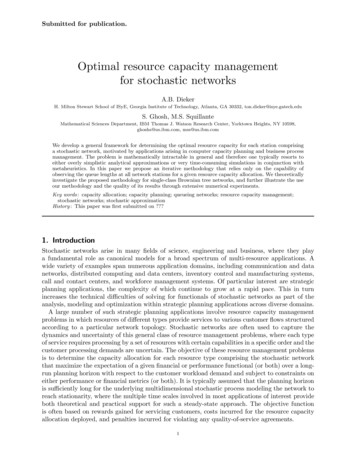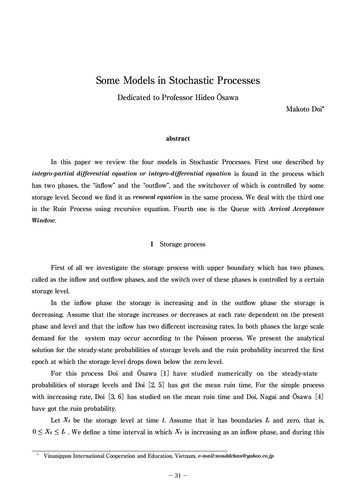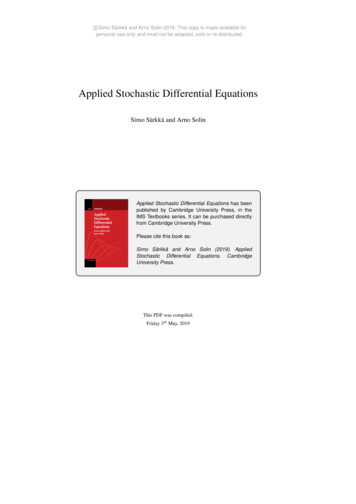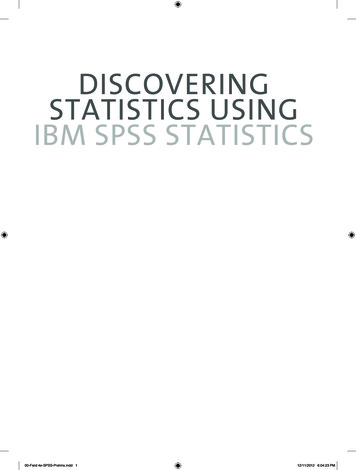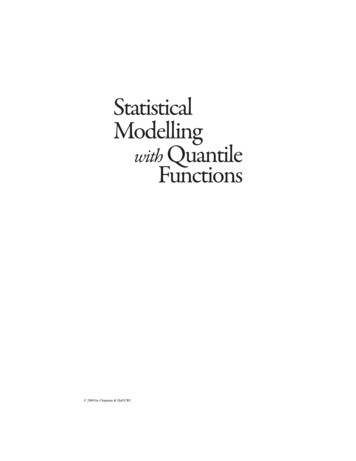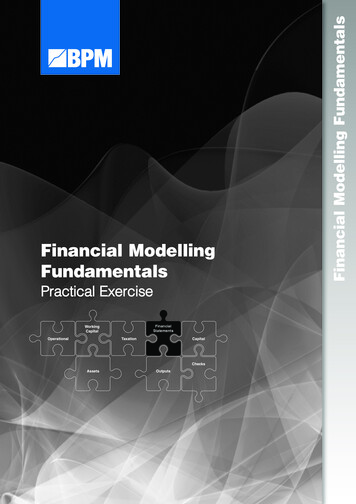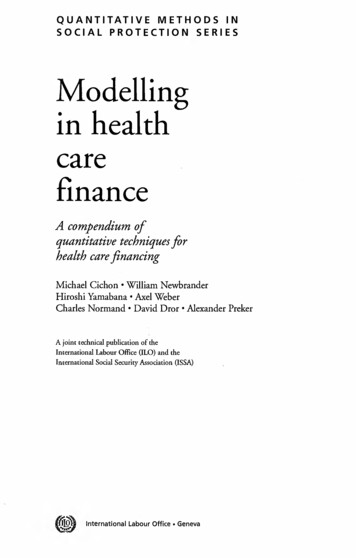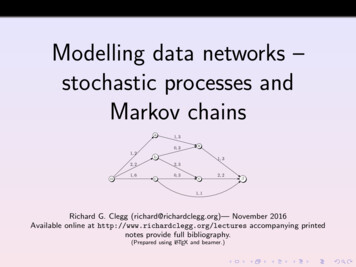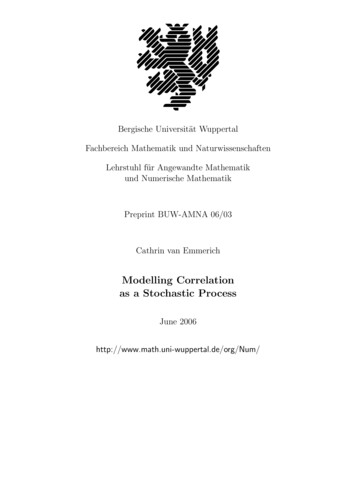
Transcription
Bergische Universität WuppertalFachbereich Mathematik und NaturwissenschaftenLehrstuhl für Angewandte Mathematikund Numerische MathematikPreprint BUW-AMNA 06/03Cathrin van EmmerichModelling Correlationas a Stochastic ProcessJune 2006http://www.math.uni-wuppertal.de/org/Num/
Modelling correlation as a stochastic processCathrin van EmmerichDepartment of Mathematics, University of Wuppertal,Gaußstraße 20, Wuppertal, D-42119, GermanyThis version: 12/06/06AbstractAlthough market observations show that correlation between stocks, interest rates, e. g.,is not deterministic, correlation is usually modelled as a fixed number. This article providesa new approach of modelling correlation as a stochastic process which has applications inmany fields. We will show an example from financial markets where the stochasticity ofcorrelation is a fundamental source of risk: the quanto.Keywords: Correlation, stochastic processes, mean-reverting processes, finance, FokkerPlanck equation.1IntroductionStochastic modelling is an essential tool in applications as different as finance, biology, medicalscience etc. As soon as there is more than one factor to consider, the question arises how to mapthe relationship between these factors. A widely used approach is to use correlated stochasticprocesses where the magnitude of correlation is measured by a single number ρ [ 1, 1], thecorrelation coefficient. In the case of two Brownian motions W 1 and W 2 correlated with ρ, onecan express this concept by the symbolic notationdWt1 dWt2 ρ dt .If ρ 0 the Brownian motions are uncorrelated. The usual assumption about filtration etc. mayhold. See for example Øksendal[5]. We will concentrate in the following on correlated Brownianmotion. Further work must show how the idea can be extended to other distributions.In finance correlated Brownian motions appear for example in the Heston model[2]pdSt µSt dt Vt St dWt ,pdVt κ(θ Vt )dt σ Vt dZt ,where µ 0, κ 0, θ 0, σ 0 are constant. The first process is used to describe the movementof an underlying asset S and the second process describes the assumed behaviour of the volatilityV.Another example of coupled stochastic processes is the following Black-Scholes model forquantos (see also section 6):dSt1 µ1 St2 dt σ1 St1 dWt ,dSt2 µ2 St2 dt σ2 St2 dZt ,1
with positive constants µ1 , µ2 , σ1 , σ2 . Here one of the stochastic differential equations is supposedto map the performance of a traded object (stock or index, for instance) in a currency A. The second stochastic differential equation describes the exchange rate between currency A and anothercurrency B. Within both examples one usually assumes the Wiener processes to be correlateddWt · dZt ρ dt ,(1)with a constant correlation factor ρ [ 1, 1]. There are few approaches to extend this concept,see for example Burtschell et al. [1]. We will include randomness and time factor in the following.Moreover the process we propose possesses an intuitive interpretation which makes it a valuablemodelling tool.For motivating our model we look on the market behaviour of correlation. It indicates that’correlations are even more unstable than volatilities’ as mentioned by Wilmott[7].Figure 1 shows the estimated correlations between Dow Jones and Euro/US-Dollar exchangerate on a daily basis. Hereby it is assumed that both processes follow a lognormal distribution.Figure 1 (A) clearly shows that correlation is not constant over time. Moreover, correlation seems0.80.080.60.07Historical 8-1-1-0.8-0.6-0.4-0.200.20.40.60.81Figure 1: Correlation between Dow Jones and Euro/US-Dollar exchange rate, process and density.(A): Estimated historical correlation over time. (B): Empirical distribution.even to be nondeterministic. In figure 1 (B) we receive a first impression how the density of astochastic process modelling correlation could look like. That is the motivation for this report.We want to model correlation such that it is concentrated on [ 1, 1], it varies around a mean, the probability mass approaches zero in the boundary values, there is a suitable number of parameters to calibrate the model to market data.The outline of the remaining sections is as follows. First we present different approaches formodelling correlations as stochastic processes (section 2 and 3). In section 4 and 5 we examinethese mathematical models analytically. Finally we analyse how theses processes can be used forpricing and apply the results exemplarily to a particular financial derivative, a quanto (section 6).2Construction of Fully Stochastically Correlated Brownian MotionsBefore we introduce suitable processes to model correlation, we show how to construct Brownianmotions correlated with a stochastic process. These will be called fully stochastically correlated2
processes.As this is an extension of the constant correlation case, it is a natural requirement that the newconcept should cover the constant case. First we assume thatρ0 [ 1, 1] ,dρt a(t, ρt )dt b(t, ρt )dKt ,is an Ito process with a Brownian motion K and suitable functions a and b. Based on twoindependent Brownian motions V and W (also independent of K), we defineZt(2)Zt Zt pρs dWs 1 ρ2s dVs ,0Z0 0 .0For proving that Z (2) is a Brownian motion, we remark that Z0 0 and show that E [Zt2 ] t.Because of the Ito-isometry, we can calculate: 2 Zt E Zt2 E Zt pρs dWs 0with Mt : Rt0ρs dWs 2 1 ρ2s dWs 2Mt t .0Rtp0dMt ρt dWt1 ρ2s dVs . We used that E[Mt ] 0 which follows from M0 0 andZt p1 ρ2s dVs p1 ρ2t dVt0Ztρs dWs ρtp01 ρ2t dWt dVt . {z } 0In a similar way, one verifies that E [Zt Fs ] Zs , t s. Thus we have two Brownian motions Wand Z correlated by the stochastic process ρ.Especially it holds for W and Z that t ZE [Zt · Wt ] E ρs ds 0which agrees for constant ρ with the symbolic expressiondZt · dWt ρ dt .This construction should be borne in mind throughout the remaining parts of this article.3Models for Fully Stochastic CorrelationWe present two ways to construct stochastic processes which remain in the interval [ 1, 1]. For thefirst approach the new stochastic process is directly formulated as a function of Brownian motion.It stands out because of the ease of construction and the high degree of analytical tractability,but lacks intuitive interpretation. This is the reason why we focus on the second approach lateron where the new stochastic process is described by a stochastic differential equation driven byBrownian motion.The first and most important property of a process for modelling correlation is that the processmust stay within the interval [ 1, 1]. Based on a Brownian motion W(3)Xt 2arctan (α(Wt γ)) ,π3
surely is in [ 1, 1] since2arctan (α(x γ)) ,πmaps ( , ) to ( 1, 1). Following this train of thought, we can also choosef (x) (4)f (x) 2 1,1 x2or in general every transformationf : ( , ) [ 1, 1] ,f C 2 (R) .Obviously not all of these possible processes are suitable. Exemplarily we analyse the expectationfor (3). Note that the initial value is given by22arctan (α (W0 γ)) arctan (αγ) ,ππsince W denotes a Brownian motion. Using Ito’s formula, we obtain the following representationfor (3) π π π 2α22αdXt sinXt cos3Xt dt cos2Xt dWt .π22π2Thus the expectation is t2 Z2αππE [Xt ] X0 E sin( Xs ) cos3 ( Xs )ds .π22X0 0This expectation depends on t and cannot be computed in general. Apart of this technical problem the approach lacks intuitive interpretation which is necessary as we want the process to mapcorrelation. Because of its insufficient justification which also holds for similar transformations,we cannot consider these transformed Brownian motions as appropriate modelling tools. Therefore we present a second approach.The process(5)dXt p(1 Xt )(1 Xt )dWt ,with initial value X0 x0 ( 1, 1) guarantees values in [ 1, 1] (see also section 4). It isstraightforward to generalise (5) top(6)dXt α (1 Xt )(1 Xt )dWt ,α R , X0 x0 ( 1, 1) ,which also remains in [ 1, 1], but allows more freedom.The expectation of (6) can be computed as t Z p(1 X)(1 X)dW x0 .E [Xt ] X0 E α0which is constant over time. Thus there are two parameters to calibrate the model to marketdata: α and x0 .We can extend (6) by adding a drift term. Motivated by the practical example in the introductorysection we choose a mean-reverting process with - for simplicity - deterministic mean:p(7)dXt κ(θ Xt )dt α 1 Xt2 dWt ,X0 x0 ( 1, 1) ,with constants κ 0, α 0, θ ( 1, 1). The assignment κ 0 yields model (6).At this point we do not know much about (6) and (7). In the following section, we discussanalytical properties with focus on the boundary behaviour at 1 and 1. Afterwards we studythe process with the aid of the Fokker-Planck equation in section 5.4
4Analytical Properties of (7) - BoundariesFirst we classify the boundaries 1 and 1. Hereby we follow the notation of Karlin and Taylor[3].We start with a general Ito diffusion(8)x0 R .dxt a(xt )dt b(xt )dWt ,Moreover we denote the left boundary by l and the right boundary by r in the sense l x r.Without loss of generality we concentrate on the left boundary in the following. The analysis ofthe right one works analogously. Now we introduce some notations, thereby we assume x (l, r), v Z2a(w) s(v) exp dw ,v0 (l, x) ,b2 (w)v0Zxx0 (l, x) ,s(v)dv ,S(x) x0ZdS[c, d] S(d) S(c) (c, d) (l, r) ,s(v)dv ,cS(l, x] lim S[a, x] .a lWe already indicate that x0 and v0 will be of no relevance in the following. We use that dS(x) s(x)dx. S is called the scale measure whereas M is the speed measure:1m(x) b2 (x)s(x),ZdM [c, d] m(x)dx .cAnalogously we can use the relation dM (x) m(x)dx. Lastly we need the expressionZxΣ(l) limM [v, x]dS(v) .a laUsing these notations we can classify the left boundary. The boundary l is called attractive ifand only if there is an x (l, r) such thatS(l, x] .(9)Furthermore l is classified as an attainable boundary if and only ifΣ(l) .(10)Otherwise it is unattainable.We are going to determine S( 1, x] for the mean-reverting process (7). We compute s(x) asa first step:Zv log (s(v)) κκ2κ(θ w)(θ 1)(1 θ) 1α2α2dw log(1 v)·(1 v)·c0α2 (1 w2 )v05
with c 10 1 v01 v0 θκ2α · (1 v02 )κα2. Consequentlyκκs(v) c0 · (1 v) α2 (θ 1) · (1 v) α2 (1 θ) .For the behaviour near the left boundary l 1 we have to investigateZxκκS(l, x] lim c0 · (1 v) α2 (θ 1) (1 v) α2 (1 θ) dv .a laWe note that (1 v) 0 for v [a, x] ( 1, 1) and ακ2 (1 θ) 0 . Therefore the termκ(1 v) α2 (1 θ) is bounded for v [a, x]:κκ(1 v) α2 (1 θ) (1 a) α2 (1 θ) 0 ,κκκ(1 v) α2 (1 θ) (1 x) α2 (1 θ) 2 α2 (1 θ) .Applying the first inequality we can estimate as follows S( 1, x] lim (1 a)κ(1 θ)α2a 1Zxc0κ(1 v) α2 (θ 1) dv .aThis expression converges to a constant C R if ακ2 (θ 1) 1, otherwise it diverges. Hence theboundary l 1 is attractive if ακ2 (θ 1) 1. By applying the upper bound one shows that itis not attractice if ακ2 (θ 1) 1. Analogously we can deduce that the upper bound r 1 is notattractive if ακ2 (1 θ) 1. This boundary behaviour meets intuition. Increasing the parameterκ concentrates the process around the mean.Furthermore the boundary behaviour is symmetric with respect to θ. For θ close to 1 theparameter κ needs to be decisively larger to make the boundaries 1 respectively 1 not attractive.Now we are going to figure out if the left boundary is attainable. We remark that onlyan attractive boundary can be attainable (see definition for Σ). For that reason we assumeκ(θ 1) 1 in the following. For notational simplicity, let c denote a suitable constant in theα2remaining part of this section. We considerZxZxΣ( 1) limM [v, x]dS(v) limS[a, v]dM (v)a 1a 1aaZx Zv lims(w)dwa 1a1b2 (v)s(v)dv .aFirst we calculate Σ( 1) for κ 0:cΣ( 1) log2α2 4(1 x)2 .Hence the boundary l 1 is attainable if κ 0. Moreover we can deduce that Zx Zvκ1 (1 w) α2 (θ 1) dw dvΣ( 1) c lim2a 1β (v)s(v)aaZx(1 v)1 α2 (θ 1) (1 a)1 α2 (θ 1) c limκκκa 1a κ(1 v 2 )(1 v) α2 (θ 1) (1 v) α2 (1 θ)Zx c lima 1κ1dv lim (1 a)1 α2 (θ 1)Zxa 1aa6dv κ(1 v) (1 α2 (θ 1)) dv .
This last integral converges if 1 ακ2 (θ 1) 1 which clearly holds as θ ( 1, 1). The expressionκ(1 a)1 α2 (θ 1) converges because of the attractiveness condition ακ2 (θ 1) 1. Thus the leftboundary is attainable (and attractive as shown above) if ακ2 (θ 1) 1. Otherwise the leftboundary is not attractive and unattainable.Following the same line of thought one derives that the right boundary r 1 is attractive andattainable if ακ2 (1 θ) 1. Otherwise it is neither attractive nor attainable.As we want the boundaries of our correlation process to be unattainable we will consider process (7) withκ (11)α21 θin the following.The classification of the boundaries is a first step for a deeper understanding of the underlyingprocesses. We investigate the transition densities for further insight.5Analytical Properties of (7) - Transition DensityWe use the Fokker-Planck equation for determination of the transition density. For more information about the Fokker-Planck equation we refer to the book by Risken[6]. For simplicity weset α 1. Assuming that the stochastic differential equation(12)dXt a(t, Xt )dt b(t, Xt )dWt , X0 x0 ,possesses a transition density p(t, y x0 ), then p satisfies the Fokker-Planck equation(13) 1 22p(t, x) (a(t, x)p(t, x)) b(t,x)p(t,x) 0. t x2 x2We want to derive the transition density of (7) for t . We demand the solution p to fulfilltwo structural conditions. Firstly p is required to be a densityZ1(14)p(t, x)dx 1 . 1Moreover we postulate that p preserves the expectationZ1x · p(t, x)dx θ .(15)t 1For the mean reversion process (7) with (11) one can show that every two solutions of (13) areequal for t under certain conditions, see Risken[6], section 6.1. As a consequence it sufficesto show that a stationary solution exists to know that it is the unique solution. This is how weproceed in the following: We will derive a stationary solution which fulfills (14) and (15). Thissolution suffices the conditions stated in Risken[6].To obtain the stationary solution p(x) lim p(t, x), we consider the stationary Fokker-Planckt equation. Firstly we examine the simplified case θ 0:(16)1(1 κ)p(x) x(2 κ)p0 (x) (1 x2 )p00 (x) 0.27
We receive as a solution to (16) p(x) (1 x2 )(κ 1) c b(17) Z11 z 2 κdz xwith constants b, c R. If b 0, p is symmetric around x 0. HenceZ1x · p(x)dx 0 θ , 1and (15) holds. Thus we choose b 0. The still free variable c must be chosen such thatcondition (14) is fulfilled. Since the antiderivative of p can be described via the hyper-geometricfunctionaba(a 1)b(b 1) 2F (a, b, c, y) 1 x x .c2!c(c 1)we obtain:Z31(1 x2 )(κ 1) dx x · F ( , 1 κ, , x2 ).22Thus we must choose c asc 2·1. κ, 32 , 1)F ( 12 , 1With this choicep(x) c(1 x2 )(κ 1)(18)becomes a density.As a next step we consider the full mean-reverting process (7) with θ 6 0. The density p is asolution of(19)1(1 κ)p(x) x(2 κ)h0 (x) κθp0 (x) (1 x2 )p00 (x) 0.2Lengthy calculations show that p(x) 1 x1 x κ·θ 1 x2 κ 1Z1· c b 12e( κ(2θ tanh (z) log(z 1))) dz xsolves (19) with b, c R. For θ 0 we want p to be equal to the above solution (18). This isonly possible if b 0. Thus the final solution is κ·θ κ 11 x1 x2,(20)p(x) c1 xR1with c such that 1 p(x) 1 holds.Figure 2 shows how the transition densities may look Rlike. As we could not compute the1constant c analytically, it is determined numerically. Thus 1 p(x)dx 1 holds for the plots.We can observe that p is concentrated on [ 1, 1]. p is symmetric with respect to θ in the sense of pθ (x) p θ ( x). If θ 0 the global maximum is attained at x 0.8
1.520 210.50.5115000 θ10 κ-0.5-0.50x00.5x5(A)-0.50.5(B)R1Figure 2: (A): Transition density (20) for varying κ [3, 20], θ 0.2, 1 p(x)dx 1, (B):R1Transition density (20) for varying θ [ 0.75, 0.75], κ 12, 1 p(x)dx 1. The probability mass vanishes when getting away from the mean. In particular, it approaches zero in the boundary values.These properties agree with intuition and what we demanded in the introductory section. Especially they correspond to figure 1. Therefore we consider the mean-reverting process (7) assuitable for modelling correlation.Remark I: Numerical calculations indicate that (20) also fulfillsZ1xp(x)dx θ . 1which is still to be proven analytically.Remark II: The transition density can be used for calibrating the parameters, see for exampleWilmott [8].6Practical Example - QuantosA quanto is a cross-currency option. It is a combination of a regular option (European, American,Asian etc.) which pays off in currency A and a currency option which hedges against the exchangerisk between A and another currency B. The quanto pays off in B. Thus the payoff is defined withrespect to an underlying noted in currency A. Then this payoff is converted to currency B.As an example we can think of a call on the Dow Jones whose payoff is paid in Euro(DowT Strike) · exchange rate0 .In the following we assume a Black-Scholes world with lognormal distribution for the underlying assetdSt µS St dt σS St dWtSand lognormally distributed exchange ratedXt µX Xt dt σX Xt dWtX .9
If the correlation between W S and W X is constant,dWtS dWtX ρdt ,an analytical solution for pricing a quanto call exists. It turns out that pricing a quanto reducesto pricing a call in the Black-Scholes setting with the adjusted constant dividend yieldrf rh ρσS σX .See for example Wilmot[7]. Hereby rf denotes the risk-free interest rate in the currency in whichS is traded (foreign currency). The risk-free interest rate of the other currency is rh (home).The remaining question is how to incorporate stochastic correlation in this framework. Weassume the model to be arbitrage free. Thus the expected return of one unit of home currency,exchanged, risk-free invested in the foreign country and re-exchanged must equal the risk-freereturn on one unit:1exp(rf T )E [XT ] exp(rh T ) .X0(21)The exchange rate Xt follows a geometric Brownian motion and thus E [XT ] X0 exp(µX T ).Insertion in (21) yields the restrictionµX r h r f .(22)In addition the arbitrage argument leads to a second restriction. Analogous argumentation asabove makes clear that1 1E [ST XT ] exp(rh T ) .X0 S0(23)must hold. Hereby the left side describes the re-exchanged expectation of an investment of onehome currency unit into the underlying S.For calculating E [S(T )X(T )] we need to computed(St Xt ) St dXt Xt dSt dSt dXt St Xt (µS µX )dt σS dWtS σX dWtX ρt σS σX dt .Ito’s formula impliesd(ln(xt )) 1 11dxt (dxt )2 .2xt2 xtApplication to St Xt leads toZT1d(St Xt ) (µS µX )T σS WTS σX WTX St Xt2 2σS2 σXT .0A further application of Ito’s formula leads to (24)ZTE [ST XT ] S0 X0 E exp (µS µX )T σS σXρdt .0Thus with the choice(25)1µS rh µX σS σXTZTρdt ,010
0.08Historical correlation0.07Transition 00.20.40.60.81Figure 3: Correlation between Dow Jones and Euro/US-Dollar exchange rate, density; empiricaldistribution vs. density (20) computed with θ 0.1, κ 10.6.the no-arbitrage condition (23) is fulfilled. Note that the choice ZT1µS rh µX ln E σS σXρdt ,T0would also be consistent with (23), but in that case the stochasticity would have been lost.Now we can use a conditional Monte Carlo approach. We simulate paths for ρ. Then we obtain aconstant expression for µS for every path. Interpreting (25) as return minus continuous dividendZTrh (rh rf σS σXρt dt) ,0we can simply use the Black-Scholes price for stocks with continuous dividend payments and geta solution for every path. Afterwards we compute the fair price of the quanto as the mean overall Black-Scholes prices.We test if stochastic correlation leads to different prices for quantos compared to the constantcorrelation case. We consider the following process for stochastic correlationpdρt κ · (θ ρt )dt 1 · 1 ρ2t dWt .(26)As above W denotes a Brownian motion. If not mentioned otherwise θ 0.1, κ 10.6. Theparameter choice results from a least-square fitting of (7) to the historical data from figure 1.This fitting is surprisingly good, see figure 3.Underlying and exchange rate are supposed to follow a lognormal distributions with σS 0.2and σX 0.4, respectively. The risk free interest rates amounts to rh 0.05 and rf 0.03. The11
underlying starts in 100, the starting value of the exchange rate is 1. The strike amounts to 120.For numerical integration the Milstein scheme is used, see for example Kloeden and Platen[4].The number of paths amounts to 10000, and the step size is set to 0.001. In none of the casesthe boundaries l 1 and r 1 have been exceeded thus we consider the Milstein scheme asan appropriate choice. This effect perfectly agrees with the result that the boundaries are notattractive for this parameter configuration.Figures 4 and 5 show prices computed for constant ρ θ using the analytic formula (continuous line). The crosses show the prices determined by simulation using our correlation process (7).40403535Constant correlationConstant correlation30302525Quanto priceQuanto priceStochastic correlation202015151010550246810Time to maturity12Stochastic correlation014246810Time to maturity1214Figure 4: Comparison of prices for quanto with fixed and stochastic ρ, (A): ρ0 0.1, (B):ρ0 0.35121130109Quanto priceQuanto price252015876510Constant correlationConstant correlation4Stochastic correlationStochastic correlation530123456Time to maturity789210123456Time to maturity78910Figure 5: Comparison of prices for quanto with fixed and stochastic ρ; (A): ρ0 0.1, κ 1.06,(B): ρ0 0.4, θ 0.4, κ 1.06.In figure 4 (A) there is no decisive difference between the prices calculated with constantcorrelation and the prices calculated with (25) where ρt follows (26). The reason is that we donot use the whole path of correlation but eventually only the distribution at T . One can easilyverify that with ρ0 θ the Milstein scheme generates random variables at T with mean θ. As themean-reverting factor κ is relatively high this distribution is strongly concentrated around themean. In contrast to that, in figure 4 (B) we can observe a difference: The prices for stochasticcorrelation are higher as for constant correlation. This is due to the fact that the expectation of12
correlation changes over time. Consequently the additional freedom we win by using stochasticprocesses for modelling correlation does have an influence on pricing.In figure 5 (A) initial value and mean are equal but here the mean reverting factor κ is smallercompared to figure 4. We observe that stochastic correlation leads to higher prices than constantcorrelation although the expectation is equal. Thus pricing with constant correlation meansneglecting correlation risk. The effect is even stronger if θ is higher as seen in figure 5 (B).7ConclusionBased on independent Brownian motions V, W, K and a given stochastic processdρt a(t, ρt )dt b(t, ρt )dKt ,ρ0 [ 1, 1] ,we constructed a further Brownian motionZtZt pZt ρt dWs 1 ρ2t dVs .00Interpreting ρt as a correlation process Z and W are stochastically correlated. We presentedsuitable functions a and b for modelling the correlation process. We focussed on (7)pdρt κ(θ ρt )dt α 1 ρ2t dWt ,ρ0 r0 .Analysis of boundary behaviour and transition density showed that it fulfills the natural featureswe expect correlation to possess.Finally we showed how to incorporate the concept of fully stochastic correlation into the modellingof a financial product, the quanto. We observed that correlation risk is neglected if we chooseconstant correlation instead of the here presented fully stochastic correlation.AcknowledgmentsThe author thanks the working group Numerical Analysis at the University of Wuppertal. Particularly she is grateful for comments of and discussion with Andreas Bartel, Michael Günther andChristian Kahl. Especially section 5 greatly benefitted from cooperation with Christian Kahl.References[1] X. Burtschell and J. Gregory and J.-P. Laurent, Beyond the Gaussian Copula: Stochastic andLocal Correlation, working paper (2005).[2] S. Heston, A closed-form solution for options with stochastic volatility with application tobond and currency options, Rev. Financ. Studies 6 (1993) 327–343.[3] S. Karlin and H. M. Taylor, A second course in stochastic processes (Academic Press, 1981).[4] P. E. Kloeden and E. Platen, Numerical Solution of Stochastic Differential Equations(Springer-Verlag, 1992).[5] B. Øksendal, Stochastic Differential Equations (Springer-Verlag, 2000).[6] H. Risken, The Fokker-Planck equation (Springer-Verlag, 1989).[7] P. Wilmott, Quantitative Finance, volume 1 (John Wiley & Sons, 2000).[8] P. Wilmott, Quantitative Finance, volume 2 (John Wiley & Sons, 2000).13
Although market observations show that correlation between stocks, interest rates, e. g., is not deterministic, correlation is usually modelled as a fixed number. This article provides a new approach of modelling correlation as a stochastic process which has applications in many fields.

